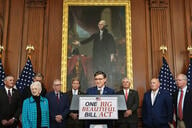You have /5 articles left.
Sign up for a free account or log in.
The institutions are designed first and foremost to prepare people for careers. They are expensive to attend, and many students borrow heavily to pay for their educations. And critics are asking increasingly tough questions about how graduates are faring in the job market -- and whether the institutions are transparent enough about their outcomes.
That description may sound like the for-profit colleges that have been under a microscope in recent years, but it also characterizes law schools, which a new report suggests might be at the bleeding edge of greater scrutiny of traditional higher education in the months ahead.
The report from the Center for American Progress builds on the drumbeat of news articles portending a crisis in legal education, but frames the law schools' issues as a potential harbinger for other colleges and universities.
“The story of impossibly high demand even in the face of climbing tuition and low success rates seems all too familiar,” writes Julie Margetta Morgan, the author. “The high enrollment, high tuition, high debt phenomenon presented in law school mirrors the rest of higher education."
Although law school applications fell last year, enrollment has increased by about 150 percent since the 1960s. Tuition has been trending upward steeply, with private law school tuition more than doubling in the last 25 years, the report states.
“But most students cannot pay for their education out of pocket. Rather they turn to the federal government for assistance,” Morgan says. Law students graduate with more debt than any other category of graduate student except for those in medicine, though their default rates tend to be low.
That's largely because lawyers have historically been employable, and well-paid: according to the Bureau of Labor Statistics, the median salary for lawyers is $129,440. But the median salary for the law school graduating class of 2010 is $63,000, and more than that, employment growth is slowing. By February 2011, 87.6 percent of law graduates from the class of 2010 had found employment. And while many law graduates choose not to practice law, the report notes, only 68 percent of the employed members of the class of 2010 were in occupations that required bar passage, the lowest in history. (That's assuming the law school placement data are accurate -- an assumption that has come into question amid some controversies and lawsuits at several schools this year.)
Bottom line, says Morgan: "the payoff to a legal education has declined," yet students continue to flock to the schools.
The report contains several recommendations. One solution, it suggests, is more information, so that law school aspirants do not labor under the impression that a law degree is an automatic ticket to a Bentley and a NetJets fractional aircraft ownership.
Morgan’s suggestions: the Bureau of Labor Statistics should publish employment and salary data for recent entrants to any occupation; accreditors in higher education should create a uniform standard for employment and salary statistics; and the American Bar Association, which accredits law schools, should be required to develop these standards to remain an accrediting body.
Those suggestions, which would essentially constitute a measure of the value of an academic program, are not totally unlike the recent Education Department regulations that try to ensure that vocational programs prepare students for gainful employment. To date, those rules have been applied mostly to for-profit colleges, but officials at those institutions and other observers have suggested that the rules -- or at least the concepts behind them -- should be applied to traditional institutions. Law schools and other professional schools that prepare people for employment could be targets.
Response to the Report
Kyle P. McEntee, executive director of the Law School Transparency Project, which aims to educate prospective students about the value of a law degree and has challenged the accuracy of law schools' placement data, said he had seen a change in the last year in how some law schools share employment data, and gave the example of Vanderbilt Law School, which has started posting statistics on its website.
“There is the perception that you can make a lot of money as a lawyer and the schools have been feeding this perception,” McEntee said. “The issue is people are getting more upset because law schools charge more and more money.”
The survey is valuable because it links the discussion about the viability of law schools to discussions about higher education, said Michael A. Fitts, president of the American Law Deans Society and dean at the University of Pennsylvania Law School.
“There has been talk of cost issues in higher education in general,” he said. “Historically, law schools have been viewed as immune from these discussions. As the economy went up and down, the legal profession has been less impacted by those pressures. But that is no longer true.”




